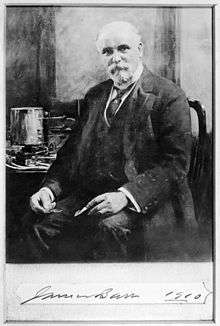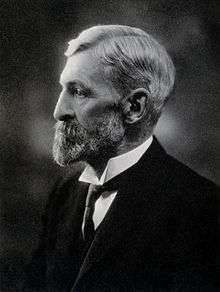James Barr (physician)
Sir James Barr FRCP FRSE CBE DL LLD (25 September 1849 – 16 November 1938) was an Ulster-born physician, who rose to be President of the British Medical Association and is noted for his work on the medical care of prisoners.


Life
He was born in Cumber, County Tyrone in Northern Ireland, the son Samuel Barr J.P. He was schooled in Derry.[1]
He then came to Scotland to study medicine at Glasgow University, graduating in 1873.
He received house appointments in Glasgow Royal Infirmary and then the Northern Hospital, Liverpool, settling in Everton at that time.
Working at Kirkdale Gaol in Liverpool as a Medical Officer he developed a strong interest in the care of prisoners, leading him to be sent to Ireland by the British Government in 1885 during a period of unrest. His promotion of the medical examination of political prisoners in Ireland sparked controversy.[2]
He gave evidence to the Capital Sentences Committee (sitting 1886-1888) and in 1891 was involved in the training of the first three hangmen who were put on the list of persons competent to perform executions.
He was knighted in 1905, a Knight of the Grace of the Order of St John of Jerusalem,[3] and appointed a CBE in 1920.
In 1907 he gave the Bradshaw Lecture. In 1912 he was elected President of the British Medical Association.[4]
Sir James was an enthusiastic supporter of eugenics. In his Presidential Address to the British Medical Association in 1912, he argued that "The race must be renewed from the mentally and physically fit, the moral and physical degenerates should not be allowed to take any part in adding to the race." [5]
He was Vice President of the Society of Constructive Birth Control and Racial Progress and a strong supporter of its founder Marie Stopes.[6]
Publications
- Judicial Hanging (1884)
- Post Sacrlatinal Nephritis (1887)
- Pleural Effusion and its Treatment (1907)
Family
He married Isabelle Woolley in 1882. They had one son, Samuel Tudor Barr,[7] and one daughter.
References
- "Former fellows of the Royal Society of Edinburgh : 1783-2002" (PDF). Royalsoced.org.uk. Retrieved 31 March 2015.
- "Art UK - Sir James Barr (1849–1938)". Art UK. Retrieved 31 March 2015.
- "Cambridge Journals Online - Proceedings of the Royal Society of Edinburgh - Abstract - Sir James Barr, C.B.E., M.D., LL.D., F.R.C.P." Journals.cambridge.org. Retrieved 31 March 2015.
- "Munks Roll Details for James (Sir) Barr". Rcplondon.ac.uk. Retrieved 31 March 2015.
- Barr, J. (1912). President’s Address, DELIVERED AT THE EIGHTIETH ANNUAL MEETING OF THE BRITISH MEDICAL ASSOCIATION. British Medical Journal, 2(2691), 157–163.
- "James Barr 1849 – 1938". Sueyounghistories.com. Retrieved 31 March 2015.
- "Diamond War Memorial Project". Diamondwarmemorial.com. Retrieved 31 March 2015.